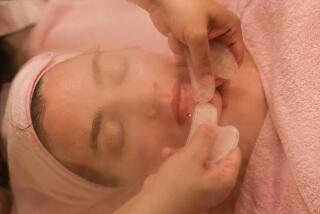Facial exercises to reduce wrinkles?
Humans can out-smile, out-smirk and out-glower every other animal on the planet, all thanks to an array of facial muscles lying just below the skin. The muscles flex and twitch throughout out the day whether we think about them or not.
Lately, facial muscles have been getting a lot of attention. Many books, DVDs and websites claim that it’s possible to lift sags, smooth out wrinkles and generally turn back the clock simply by giving the face a regular, vigorous workout.
Carolyn’s Facial Fitness, an exercise kit sold online for about $40, includes a DVD demonstrating 28 exercises that contort the face in ways you probably didn’t know were possible, a CD to help pace the exercises and an instruction booklet. For an extra $28, customers can also get a workbook with 10 bonus exercises, a double-sided mirror, samples of skin-care products and flash cards that make it easier to remember all of the different routines. Users are instructed to do all 28 exercises for about 15 minutes a day, three to five times a week.
The “Ultimate Facercise” DVD is sold at the Carole Maggio Facercise website for about $50. The DVD includes 13 exercises. Users are encouraged to do the exercises for 12 minutes every day, although the DVD also includes an eight-minute “super set” routine for busy days. Maggio is also author of the book “Facercise,” which sells on Amazon for about $10.
The claims
The website for Carolyn’s Facial Fitness says users can look five to 10 years younger after doing the exercises for six to nine months. Specifically, the exercises are said to improve the complexion and “rub out wrinkles.” Carolyn Cleaves, the former teacher and model who created the kit, says that she has been doing facial exercises for 14 years. “I’m about to turn 65, and you’d need a magnifying glass to see any wrinkles on me,” she says.
The Facercise website says that facial exercises can lift eyebrows, reduce puffiness under the eyes, smooth out the neck line, plump up the lips and create an “improved, toned, younger-looking face.” Maggio, who was a real estate agent before becoming a licensed aesthetician and opening a skin-care clinic in 1981, says that her exercises will also enhance circulation to the face, giving skin a more youthful glow.
Cleaves and Maggio both say that facial exercises encourage the buildup of collagen, proteins that help skin stay firm and toned.
Now a youthful-looking 65, Maggio says she has been doing facial exercises since the early 1980s. “People can’t pooh-pooh me anymore. My book has been translated into 18 languages,” she says. “It’s pretty hard to say it doesn’t work.”
The bottom line
Facial exercises certainly have proponents — including the television personality Dr. Mehmet Oz and even the late Jack LaLanne — but not everyone in the face field is convinced.
The exercise approach has two major strikes against it, says Dr. Francis Papay, chairman of the Dermatology and Plastic Surgery Institute at the Cleveland Clinic. For one thing, he says, there have never been any studies showing that facial exercises have any benefits. But the bigger problem, to his mind, is that the claims made for facial exercises don’t make sense.
According to Papay, heavily used face muscles are a cause of wrinkles such as crow’s-feet and frown lines, not a remedy. If someone has suffered a stroke that paralyzes half of the face, he says, the paralyzed side tends to look smoother and less wrinkly than the active side. Likewise, he explains, Botox injections work by paralyzing the muscles that cause wrinkles. “These exercises would have the opposite effect.”
Papay also says there’s no reason to believe that enhancing blood flow to the face would encourage the buildup of collagen. However, he does believe that certain neck exercises could potentially tone those muscles, which might in turn tighten up the skin along the neck and lower jaw.
Dr. Patricia Farris, a clinical assistant professor of dermatology at Tulane University in New Orleans and a fellow of the American Academy of Dermatology, says that muscles in the other areas of the face will likely stay thin and fine no matter how much exercise they get. “They’re hanging on the theory that bigger muscles will look better, but I don’t think their way of doing it is going to work. Even if you could bulk up the muscles in your forehead,” she adds, “you’d end up with a deep frown line.”
Cleaves and Maggio insist their products work; Maggio says that doubters of facial exercises are “uneducated” and should “get a life.” She acknowledges that facial exercises have never been studied scientifically, but she says that scientists haven’t studied the effects of exercise on other muscles, either (a statement that likely would surprise a lot of exercise physiologists).
Papay says that the matter could be quickly settled with a randomized clinical trial conducted by an impartial scientist. Until then, he says, any claims that facial exercises can make a person look better or younger are nothing but marketing.
Curious about a consumer health product? Send an e-mail to health@latimes.com.
Read more at latimes.com/skeptic.






